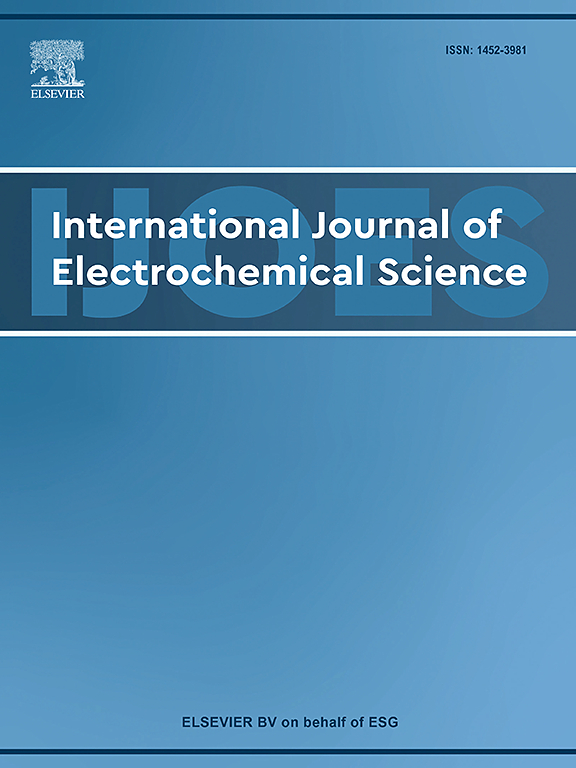从绿茶中分离的表儿茶素-3-没食子酸酯作为1018碳钢在硫酸中的缓蚀剂的电化学和计算研究
IF 2.4
4区 化学
Q4 ELECTROCHEMISTRY
International Journal of Electrochemical Science
Pub Date : 2025-06-20
DOI:10.1016/j.ijoes.2025.101092
引用次数: 0
摘要
茶花曾被研究为绿色缓蚀剂;大多数研究都集中在低碳钢上使用提取物。然而,本研究旨在检测表儿茶素-3-没食子酸酯,从茶树中丰富的儿茶素群中分离出来,证明其作为缓蚀剂比绿茶提取物更有效。几乎完全分离的表儿茶素-3-没食子酸酯具有易于复制和价格低廉的优点,与其他缓蚀剂相比,其主要优点是易于使用和获得,无污染,完全可生物降解。化合物经FTIR、1H-NMR、气相色谱-质谱等表征,证实了分离得到的儿茶素的存在。电化学阻抗谱(EIS)结果表明,随着抑制剂浓度的增加,赝感应效应减小,从而增加了对电荷转移的阻力和抑制效果。电位动力学极化曲线(PPC)显示在80和100 ppm时钝化,极化到更高电位时继续钝化。用重量试验(wt)测定腐蚀速率,用所得值计算吸附等温线。发现表儿茶素-3-没食子酸酯的吸附遵循Langmuir吸附法;这一发现得到了扫描电子显微镜的证实,该显微镜显示样品中氧和碳的含量高达100 ppm。利用密度泛函理论(DFT)得到了表儿茶素-3-没食子酸酯的优化结构。在HOMO和LUMO轨道上得到的值表明,抑制剂在金属表面上很可能是电子给体。理论和实验结果将有利于表儿茶素-3-没食子酸酯在酸性介质中抑制1018碳钢腐蚀的应用。本文章由计算机程序翻译,如有差异,请以英文原文为准。

Electrochemical and computational study of the epicatechin-3-gallate isolated from green tea leaves as a corrosion inhibitor for 1018 carbon steel in sulfuric acid
Camellia sinensis has been previously studied as a green corrosion inhibitor; most studies have focused on using the extract on low-carbon steels. However, this study aims to examine epicatechin-3-gallate, isolated from the group of catechins abundant in Camellia sinensis, demonstrating its greater efficacy as a corrosion inhibitor than green tea leaf extract. The almost complete isolation of epicatechin-3-gallate is easily reproducible and inexpensive, its main advantage compared to other corrosion inhibitors: it is easy to use and obtain, non-polluting, and completely biodegradable.
The compound was characterized by FTIR, H-NMR, and Gas Chromatography-Mass Spectrometry, which corroborated the isolated catechins. The results in Electrochemical Impedance Spectroscopy (EIS) highlight the pseudo-inductive effect that decreases with increasing inhibitor concentration, thus increasing the resistance to charge transfer and inhibitory effectiveness. Potentiodynamic polarization curves (PPC) show passivations at 80 and 100 ppm that continue when polarized to higher potentials. The gravimetric test (wt ) was used to determine the corrosion rate, and the values obtained were used to obtain the adsorption isotherms. It was found that the adsorption of epicatechin-3-gallate follows the Langmuir method through physisorption; this finding was confirmed by scanning electron microscopy, which highlighted the high oxygen and carbon contents in the samples at 100 ppm. The optimized structure of Epicatechin-3-gallate was obtained using Density Functional Theory (DFT). The values obtained in the HOMO and LUMO orbitals showed that the inhibitor is most likely an electron donor concerning the metallic surface. The theoretical and experimental results will facilitate the application of epicatechin-3-gallate to inhibit the corrosion of 1018 carbon steel in acidic media.
求助全文
通过发布文献求助,成功后即可免费获取论文全文。
去求助
来源期刊
CiteScore
3.00
自引率
20.00%
发文量
714
审稿时长
2.6 months
期刊介绍:
International Journal of Electrochemical Science is a peer-reviewed, open access journal that publishes original research articles, short communications as well as review articles in all areas of electrochemistry: Scope - Theoretical and Computational Electrochemistry - Processes on Electrodes - Electroanalytical Chemistry and Sensor Science - Corrosion - Electrochemical Energy Conversion and Storage - Electrochemical Engineering - Coatings - Electrochemical Synthesis - Bioelectrochemistry - Molecular Electrochemistry

 求助内容:
求助内容: 应助结果提醒方式:
应助结果提醒方式:


